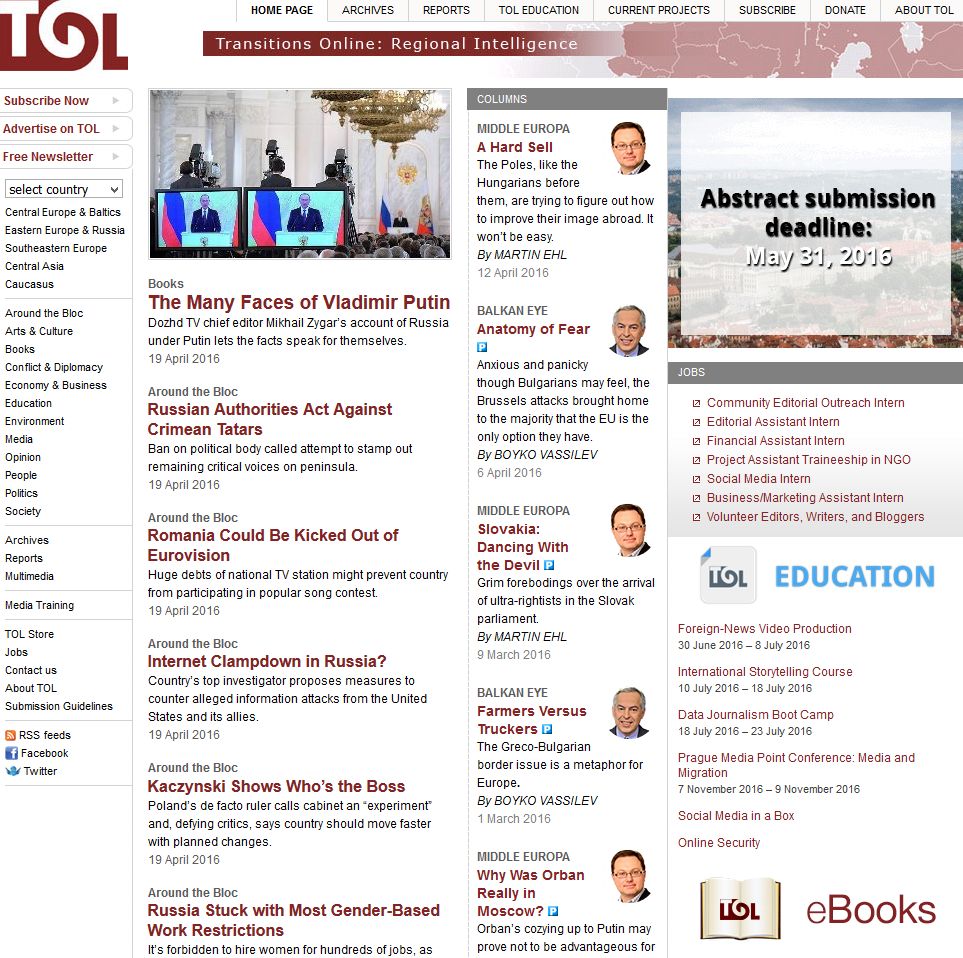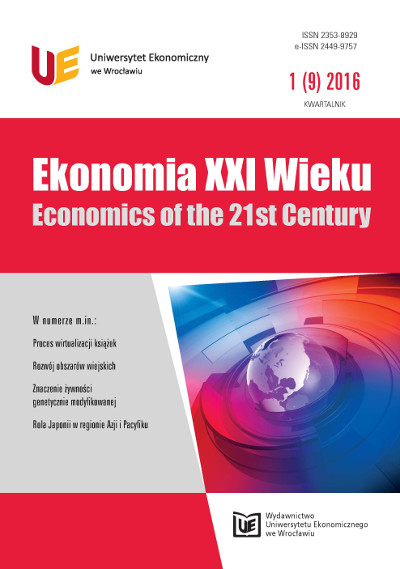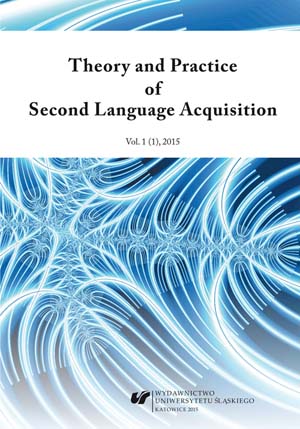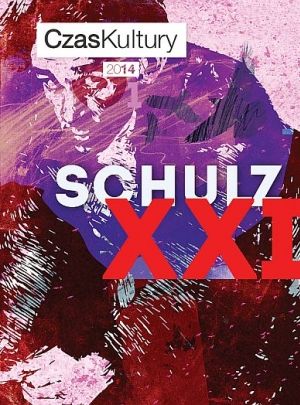
Middle Europa: A Hard Sell
The Poles, like the Hungarians before them, are trying to figure out how to improve their image abroad. It won’t be easy.
More...We kindly inform you that, as long as the subject affiliation of our 300.000+ articles is in progress, you might get unsufficient or no results on your third level or second level search. In this case, please broaden your search criteria.

The Poles, like the Hungarians before them, are trying to figure out how to improve their image abroad. It won’t be easy.
More...
In this research work; the author focuses on the analysis of the liberalisation of foreign trade policy of emerging China in the world economy. What indicates the importance and innovativeness of the research is the presentation of the technical progress in P.R.China and the benefits resulting from the liberalised Chinese foreign trade policy. In accordance with the foreign trade policy theory further trade liberalisation and improved framework policies would increase trade and promote growth. It must be emphasized that openess to trade is associated with higher incomes and growth and there is a need for new approaches to trade cooperation in the light of the forces that are currently re-shaping international business. The key of trade developments within the broader socio-economic context is especially the rise of global supply chains; the general shift of trade power away from the West towards Asia. The main aim of the article is the presentation the liberalisation of foreign trade policy of emerging China in the world economy.
More...
The article discusses the project of East Asia Summit – EAS; a manifestation of Asian diplomatic regionalism; launched in 2005 as a political forum of countries located in the region of East Asia; consistently evolving toward an Asia-Pacific platform of dialogue due to formal membership of Russia and the United States since 2011. A year before there was a discussion about the possibility of the constitution of the ASEAN Plus Eight formula. The author attempts to study the genesis of the EAS project; indicating an issue of membership in the regional diplomatic framework; while addressing Japan’s optics.
More...

The paper raises the question of whether the linguistic relativity proposal, also known as the Sapir-Whorf Hypothesis, should be used as a frame of reference for modern research into the relationship of language to cognition. The question is discussed in the context of Whorf’s (1956) writings, with emphasis on factors that are crucial to the proposal, i.e. language, thought, and behavior. The second issue addressed by the paper is whether linguistic categories provide an accurate window on cognition, as was suggested by Whorf and in some of the more recent debates. The analysis takes the form of a correlational study which examines the categorization criteria applied in tests that require language-based and language-neutral judgments.
More...
This article reports the results of a study of self-perception of their language identity by advanced FL students. The aim of the study is to observe what students’ language choices are and what guides them in these choices. The concepts related to bi/multilingualism are taken into consideration, following Cook’s opinion (1992, p. 558) that L2 users should be compared to bilinguals rather that monolinguals. The perception of the language self is related to language competence acquired in formal education. The findings will be referred to recent research on language and identity in a foreign language context conducted elsewhere, and suggestions for further study in the field will be provided.
More...
The semantically fine-grained ditransitive constructions in Mandarin Chinese show complex interaction between lexical semantics, constructional semantics, and syntactic frames. This study examines the acquisition process of the syntax as well as the semantics of these constructions by launching two experiments with French learners of Chinese. The experiment results reveal a ‘syntax-before-semantics’ learning process and the important role of input in implicit learning.
More...
In 2012, a number of events were held to mark both the centenary of the birth and the 70th anniversary of the death of the Drohobych-born writer Bruno Schulz, including memorial, public awareness and academic projects which resulted in numerous publications that helped ensure the continued vigorous growth of Schulzology in the 21st century. The year 2013 likewise provided a major impetus for the popularization of Schulz’s achievements, since in this year the copyrights to Schulz’s works expired, allowing them to be freely reproduced. A review of the most recent published works in Schulzology serves as an opportunity to ask questions of a more general nature about trends in research on Schulz’s work, which is dominated by W. Panas’ cabbalistic interpretation. This includes other readings of the author of „The Street of Crocodiles” from within a Jewish context, efforts at a radical reorientation in research and philosophical hermeneutics (M.P. Markowski), attempts to read Schulz’s work in terms of political problematics, and the phenomena of the “celebritisation” of literary criticism.
More...
This study is concerned with L2 Japanese learners’ interpretation of scopally ambiguous sentences containing negation and universal quantifier using prosodic cues. It has been argued, in previous literature, that native adult speakers of English as well as Japanese interpret such sentences both on their surface (total negation) and inverse scope (partial negation) readings in the presence of prosodic cues. The present study shows, however, that L2 Japanese speakers predominantly favor the total negation reading even in situations where the prosodic cues point them to the partial reading. These outcomes indicate that L2 learners of Japanese do not attach “optimal relevance” to prosodic cues when disambiguating scopally ambiguous sentences. The results also imply that for L2 Japanese learners, clues other than prosody may be required to carry out disambiguation.
More...
Classroom language in EFL classrooms comprises the core of communication between teachers and learners. Teacher talk plays a central role in understanding the nature of classroom language in this respect. According to Krashen’s input hypothesis, teacher talk also constitutes an important source of comprehensible input for the language acquisition of the learner (Krashen, 1981). To make the input comprehensible, teachers may make modifications in their vocabulary, syntax, rate of speech or discourse. Accordingly, the aim of this study is to discover whether native speakers of English and non-native speakers of English make any syntactical modifications in their teacher talk at elementary and pre-intermediate levels and to try to find out what kind of syntactical modifications they make if they modify their syntax during their speech. The study was carried out with eight EFL instructors (both NSs and NNSs) at Çağ University in Turkey, using their audio-recordings, a questionnaire, and interviews. Antconc 3.2.1 Program and SPSS 17.0 Program were used to analyze the quantitative data. The findings of the data were incorporated with the results of interviews forming the qualitative part of the study. The results of the data revealed that native speakers of English and nonnative speakers of English made syntactical modifications in their teacher talk at elementary and pre-intermediate levels. They ranged from subordinate clauses to the types of sentences. The findings of the study also demonstrated that syntactical modifications in the teacher talk of native speakers and non-native speakers at both levels depended on the proficiency level of the learners although not all of these modifications formed a statistically meaningful difference.
More...
The article discusses some key issues related to worldview in the work of Bruno Schulz, analyzing it through the lens of posthumanist philosophy. In the article, issues such as Schulzian anthropology, the notion of principium individuationis, and the position of the author of "The Street of Crocodiles" in relation to civilizational change are presented in discourse with critical readings of Schulz’s writing. Aspects hardly noticed in previous interpretations are brought to the fore, such as, the laboratory featured in the stories, and the depiction of Egga van Haardt and the convalescent in the essay “A Skeptic’s Wanderings”. The demiurgic acts of the Father in Schulz’s stories are considered in light of artistic activities within mainstream bio art. The author explores Schulz’s characteristic prosthetic principle of creation, relating it to both the construction of bodies and a philosophy of Schulz’s language.
More...
This study explores the dynamic, interactive relationship between teacher identity and authenticity. Through an examination of several socio-cultural (social identity, situated learning, and image text) and psycholinguistic (individual differences) second language acquisition theories, a conceptualization of identity is provided. Subsequently, language teacher authenticity is characterized from both a philosophical and pedagogical perspective and connected to the notion of teacher identity. The final section of the paper presents research-based applications that include reflecting critically, redefining personal credibility, discovering one’s personal style, displaying emotion and recognizing diversity to facilitate the positive-broadening quest of aligning one’s identity (i.e., who I am) with authenticity (i.e., what I do).
More...
The article focuses primarily on the ontological status of the object. Schulz’s stories often feature as nodal points ordinary things that in the eyes of the characters are transformed into extraordinary things. To describe this transformation, the author focuses on one story – “Spring”. The main aim of the texts is to reconstruct Schulz’s ideas about the ontology of things. Heidegger’s late philosophy is used as the instrument for carrying out this reconstruction. The author tries not to overuse Heidegger’s nomenclature; however, he extracts from Schulz’s story the figure of the “quadrilateral”, the “Between” that exists between the earth and sky, and the gods and mortals.
More...
The author draws up her attention to a certain, so far unnoticed, methodologicalproblem connected with the presence of regionalisms in literary works written in thecommon Polish language. Regionalisms most frequently appear in literary works due towriter-intended stylizations. They can also be used in belles-lettres if a writer uses hisown regional variety7 of the national language.This article presents another way for introduction of linguistic regionalisms into li-terary works - pursuant to the "cognitive-emotional fascination of the region". Accordingto the author, this notion is not a scientific category, but solely a proper way to describespecific situations in the literature. She bases her considerations on the cognitive-emo-tional fascination of Eliza Orzeszkowa (1841-1910) by the Polish language of the noblebackwoods of the Grodno region in her novels On the Niemen and Bene nati and of JôzefLobodowski (1909-1988) by the regional Polish language of the Polish-Ukrainian borderregion in his Ukrainian Poems.
More...
Having compared the distribution of the colour gold in the poetical output of Adam Mickiewicz, Julian Tuwim, Maria Pawlikowska-Jasnorzewska, Stanisław Grochowiak and Zbigniew Herbert with that of Leopold Staff, I conclude that it is by far most widespread in the poetry of the latter - a classicist. Apart from some standard vocabulary, which was commonly used by all seven of the above-mentioned poets (złocisty, złocony, złoto,zloty) and well established in both spoken and written variants of early 19th century Polish, Staff used various lexical individualisms. They were mostly adjectival (often compound), but occasionally also nominal and verbal (in their singular form), e.g.: brzęczyzłotka,przezłacać się. rozzłocić, purpurowozłoty, rudozłoty, złocistokiłosy, złotoszczery. Such frequent occurence of lexical components designating colour gold provided light reflexesto the pictures painted with the poet's words. Semantic poetisms, such as: topaz słońca, ciepły bursztyn lasu, dźwignęłaś lasy [...] w bursztyn i topazy, etc., deserve a separate attention, since they greatly deepen poeticisation of the landscapes and other elements of the represented world. Designations of colour gold are especially prominent in the early volumes of Staff's poetry, i.e. those published by the 1920's. In the later period, the poet's use of the designations of all colours (not only colour gold) becomes increasingly rare,due to Staff's turn towards more concise and condensed lyrics at the cost of abandoninglonger poetic forms, i.a. his long beloved sonnet.
More...
The primary aim of this paper is to discuss the staging of The Street of Crocodiles by the group Complicite in 1992. The performance was based on Bruno Schulz’s "The Street of Crocodiles" and "Sanatorium Under the Sign of the Hour Glass" and was inspired by his biography. Complicite is at present one of the most exciting British theater groups with an international focus. In relating the history of Complicite, as well as its foundations and methods, the author shows how its production of "The Street of Crocodiles" represented an attempt to capture the fluid and changing reality found in Schulz’s prose. Moving away from the primacy of the text, and shifting the centre of gravity to the physical and creative dimensions of the performance made it possible to create art deeply immersed in the Schulzian universe. What seems untranslatable has been translated onto the stage, and Schulz’ prose has proven to be an excellent means for rendering it in accordance with contemporary sensibilities.
More...
The aim of the article is a reconstruction of the image of the city and its inhabitantsdone on the basis of nearly seventy songs found in Łódź folklore texts from the interwarperiod.The regionality of folklore texts is shown in particularly strong way in the image ofthe city and its space. It is indicated by local names, authentic urban object names: cafes,restaurants and also by quite realistic image of the city.In the contrary, the picture of two main social classes of inhabitants - the factoryworkers and the outcasts of the society - is rather standardized, typical and generalized.If we compare the texts from Łódź to the texts from Warsaw, striking similaritywill be easy to observe. The resemblance is obvious in the naming (personal names), thelanguage used by the social classes, and in the way of evaluating the social attitude - par-ticularly in relation to the criminal world.
More...
The article analyzes the plants cultivated by Sophie, the heroine of the poem PanTadeusz by Adam Mickiewicz, on the windowsill in Soplicowo mansion.
More...
The article brings up the issues of nineteenth-century mesmerism in the works of Bolesław Prus. It describes the coming out of the phenomenon, views of its rationalization and démocratisation both from global and Polish perspective. Moreover, it draws attention to those components of the author's biography, such as the acquaintance and cooperation with Julian Ochorowicz, which influenced the shape of his outlook on the spiritualism enthusiasts movement, quite popular at that times. The writer's attitude towards the new phenomenon was ambiguous and traces of his internal dilemmas are easily found in the language of "The New Woman". The analysed language which creates spiritualistic discourse is represented by general names i.e. names of the doctrine created by Allan Kardec or the reality it concerned; names of the rituals—meetings of people and spirits as well as the names of people and beings, directly or indirectly engaged in those rituals.
More...
The paper aims at presenting the way in which Vladimir Nabokov uses coloursand light while creating different layers of reality in his literary works on the exampleof the short story entitled Details of a Sunset. As it is shown in the article, colours in thetext convey not only the information about the visual effects but also some informationreferred to the protagonists and the plot. For instance, in Details of a Sunset the colours ofgreen and ginger used with their symbolic meaning for Clare describe her personality andattitude toward her fiance. What is, however, more important colours in the text make itpossible for the reader to recognise two different realities that determine understanding ofthe title as well as the whole text.
More...